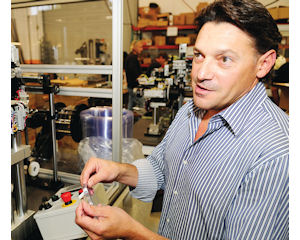Marc Freedman sees his company Dynamic Automation as more than just a supplier of automated equipment for the life sciences and aerospace industries. The Simi Valley firm is a barometer of sorts for the general health of the Southern California manufacturing industry, as the machines it makes are capital goods requiring a significant outlay of cash. “For a company to invest in that they are willing to project the economy will be stronger,” said Freedman, president of Dynamic Automation. On a recent workday, company employees worked simultaneously on an aircraft fastener assembly machine for a Commerce-based aerospace company, a machine that cuts surgical tubing for a Camarillo medical device maker and a machine that makes subcomponents used in photovoltaic solar cell assemblies. Dynamic Automation’s strong business has made it No. 34 on the Business Journal’s list of Fastest Growing Private Companies. Revenue grew 31 percent to $4.1 million from 2009 to 2011. After downsizing when the economy hit bottom, Freedman hired back laid-off employees and in the past 18 months added salespeople, electrical engineers and machine builders. A vacancy remains for a controls engineer. But isn’t local manufacturing supposed to be in decline? Over the past decade, California’s manufacturing base has eroded by a third and since 2010 the state has lagged behind the rest of the country in terms of increasing manufacturing employment, according to the California Manufacturers & Technology Association. Still, Los Angeles County remains the largest manufacturing county in the United States when ranked by jobs, with about 390,000 employed in the sector as of 2009, according to a recent report by the Los Angeles County Economic Development Corp. What’s more, Dynamic Automation has tapped into growing niches with the industry. It is in making 50 percent of its sales to pharmaceutical and medical device companies, a market that for the foreseeable future will need automated equipment for assembling medical devices, filling syringes and testing parts used in surgical equipment, among other uses. Customers include the industry’s biggest names including Amgen Inc. of Thousand Oaks; Baxter International Inc., with facilities in Thousand Oaks; and Genentech Inc., headquartered in South San Francisco. “All of that industry is going to remain stable and strong given the aging population,” said John Anderson, director of the industry consulting business unit for California Manufacturing Technology Consulting, a Torrance consultancy. Challenging times Dynamic Automation was founded in 1986 but Freedman didn’t enter the picture until 1999. His career to that point included 12 years at the San Onofre nuclear power plant, followed by starting a snowboard company that he later sold. Freedman was looking to buy a small manufacturing company and inquiries in the industry led to Dynamic Automation. He took over as president on April 1, 1999, a date he remembers because employees thought the change in ownership was an April Fool’s joke, Freedman said. The 15 years running the company has been challenging at times, and not just due to the economy. California regulations, worker’s compensation requirements, and environmental policies make the state a tough place for manufacturers. It is only one of three states that taxes new equipment purchases, said Gino DiCaro, spokesman for the California Manufacturers & Technology Association. “That can only be seen as a significant competitive disadvantage for California manufacturers,” he said. The response by Dynamic Automation is to rely less on customers in Southern California. A veteran sales manager was hired to spur business development in other states. There is also a vigorous attempt to educate potential customers on how automation can reduce their bottom line. “It requires us to be proactive,” Freedman said. “Instead of waiting for them to come to us, we went to them and asked how we could serve their needs.” The company also spends time and money on research and development to build advanced machinery. For example, it has patented a device that uses laser sensors to check the seal of a stopper covering a drug vial. The accuracy of the sensors is much better than manually checking the stoppers and reduces the number of vials that are rejected, Freedman said. Three of these machines are in use, and two more are on order. Dynamic Automation is working with pharmaceutical companies with filling operations to help upgrade their existing lines with the new technology. “We expect this to represent 20 percent of our business within three years,” Freedman said. Elaborate process All the machines made by Dynamic Automation start with mechanical design and control engineers coming up with a 3-D concept of how the machine will assemble and perform quality control of the product being made. The metal cutting for the machine’s parts is done by an outside vendor and sent back to Dynamic for final assembly and testing. The whole process can take anywhere from three to 15 months. “When you flip the switch and take it through its paces, that’s when it get interesting,” said Freedman, who credits his employees with creating the collaborative working environment that makes such innovation on each machine possible. Joe Lee of Monogram Aerospace in Commerce concurs. His company is a major supplier of fasteners to Boeing Corp. and European aircraft manufacturer Airbus Industrie, and it owns multiple machines made by Dynamic Automation. Last month, Dynamic Automation was building yet another fastener assembly machine for Monogram, one capable of making 30 parts per minute. Testing of the machine had the three individual parts for the fasteners, which were fed onto lines for assembly. The good fasteners fell into a green bucket and the rejects went to a red bucket. Lee said that spending time on the shop floor shows how experienced the employees are and how they follow Freedman’s lead and attitude. “You can tell is it is a robust team environment,” he said.
